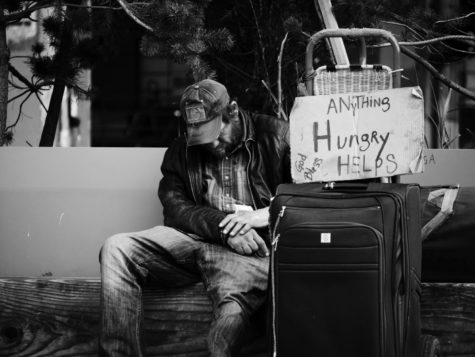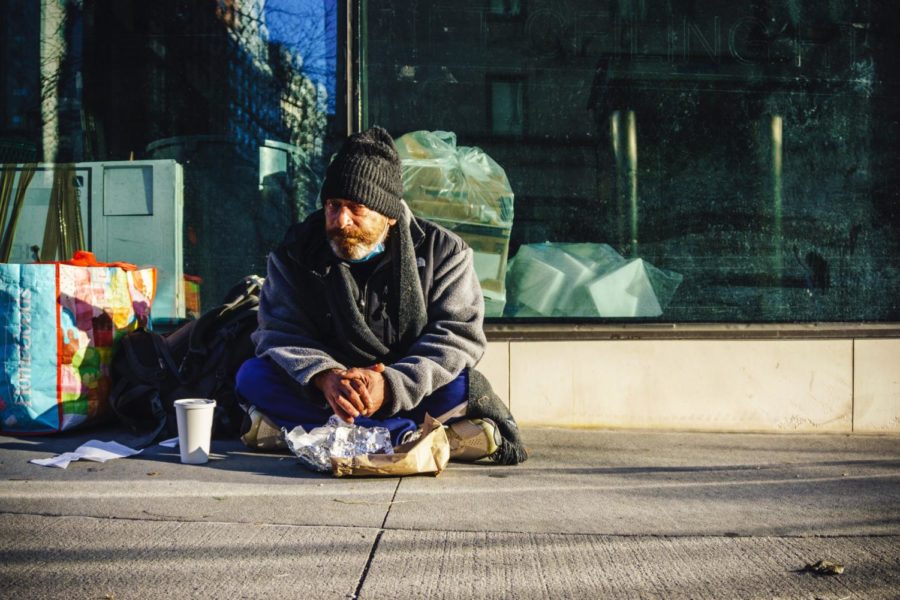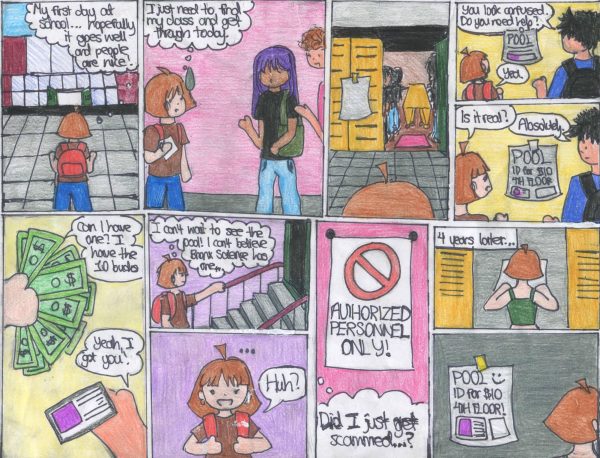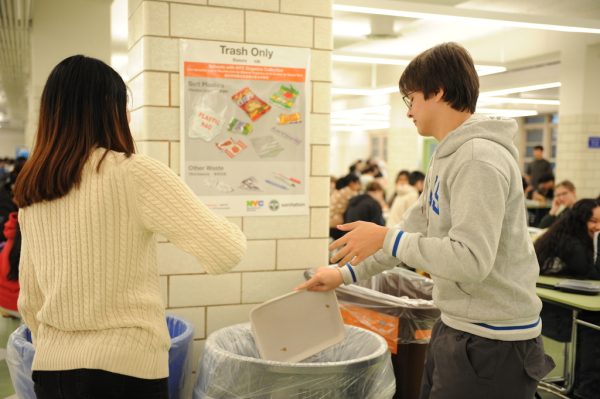Those Without a Home During the Coronavirus Pandemic
An analysis of what still needs to be improved within homeless shelters in order to ensure that those facing housing insecurity have somewhere safe to stay during these unprecedented times.
A homeless man sits on the ground on a New York City sidewalk, enjoying a coffee and a small bite to eat. This is an example of how public spaces are currently being used by the homeless community.
Almost every day New Yorkers are met with the solemn faces of those who do not have a home, those who have to put their dignity aside to ask people passing by for money or for something small to eat. Anyone would be scared to have this become their reality, yet as of now, we have allowed 80,000 women, men, and children in New York City to wake up to this reality every day.
To mitigate New York City’s homelessness problem, politicians have presented several solutions, in particular, homeless shelters. Since their introduction in 1889 by Jane Adams, homeless shelters have been a safe haven for those looking for a bed to sleep in and a hot meal. With the ongoing COVID-19 pandemic, these places have played a more important role than ever before, functioning as a means of escape from the deadly virus. Still, the issue of balancing the positive effects of these shelters with the negative ones remains.
In March of 2020, COVID-19 hit the United States, and with hospitalizations increasing by the minute and with little to no information on how to prevent the spread, people went into quarantine in order to protect themselves and their family members. Many, like myself, had the privilege to confine ourselves in the walls of a place we called home. However, the homeless population did not have the same luxury. Politicians wanted to slow down the spread of the Coronavirus, so they attempted to move the homeless community off the streets and into unused spaces, with locations like hotels serving as temporary shelters. Although this was a great initiative to give the homeless a reprieve from the dangers of the pandemic, these new shelters only further exposed problems that shelters have had since before the pandemic even started.
Recent data shows that despite the increased number of homeless shelters, the homeless more often choose to stay outside. When taking a look at their reasoning, it is evident that people still do not feel comfortable and safe in homeless shelters, nor do all shelters provide the resources necessary to help people make a life away from homelessness. A statistic from The City demonstrates that “three of four people questioned had spent some time in shelters, with 38% saying the main reason they left was their concerns about personal safety.” This aligns with data collected from The Bowery Mission, which affirms that every night in New York City, nearly 4,000 people sleep on the street, in the subway system, or in other public spaces.

These statistics take on more of a negative connotation when paired with reports from the New York City Police Department, that state that just in this month, crimes have increased 22%. This data not only further exposes the realities of living on the streets of New York City, but also the fact that the homeless community is still choosing to stay outside and fend for themselves. The main issue though is that crimes don’t just take place outside, but also in homeless shelters themselves. With cases of violence, sexual misconduct, and robbery in shelters, public spaces are starting to seem more appealing to the homeless community.
Before we can begin making improvements, however, we must first acknowledge what shelters in New York City have done correctly in their valiant efforts to ensure that the homeless community is getting the support that they deserve. Authors of a California State University research paper detail the many programs and resources that shelters have to enable their inhabitants to escape homelessness. These programs would allow for students to continue their studies, teach fiscal responsibility, learn how to enter the workforce, maintain a job, and always have something to fall back on. Programs like these give upward mobility to those that stay at the shelters for a significant amount of time.
When it comes to supporting the homeless community, we cannot be satisfied with the bare minimum. This sentiment was echoed by Sarah Derkach ’22, who said, “The issue I found was that many within the homeless shelters come from positions in which finding a new job or any form of stable income is that much more difficult to come by. Despite the efficacy of the current system, it seems as though the process of transition is lacking.” To combat the issues that Derkach and others have seen within shelters, we must continue to provide the correct resources and programs that push those dealing with homelessness to move towards decisions that better their situation, not keep them stagnant.
This means hiring more trained professionals to work in shelters and providing better care for those who choose to stay in them. It’s more than education — at this point, it’s about being aware and not being complacent with the problems that we have created within our society relating to homelessness. Being homeless is hard enough; a place that is supposed to be a safe haven should not add additional difficulty. Safety and comfort should continue to be priorities as we continue through the pandemic, and even beyond that.
Overall, there is still much to do when it comes to attacking homelessness, but in the meantime, it is imperative that we continue a track of upward mobility for those facing homelessness, and housing insecurity as a whole. Homeless shelters provide a space for the less fortunate and it is important that as a community we come together to ensure that these shelters continue to uphold the values for which they were created in the first place. The systems that we have put in place have made others suffer, and as a result, we must work to correct those wrongs and bring justice.
“The issue I found was that many within the homeless shelters come from positions in which finding a new job or any form of stable income is that much more difficult to come by. Despite the efficacy of the current system, it seems as though the process of transition is lacking,” said Sarah Derkach ’22.
Sarah Infante is a Staff Reporter for ‘The Science Survey’. This is her first year on the journalism staff, and she finds herself fortunate to be able...











